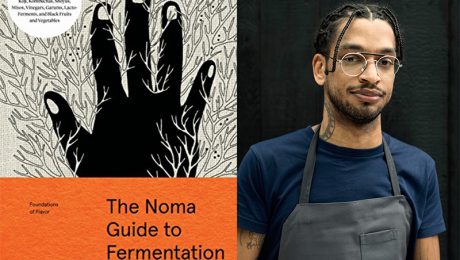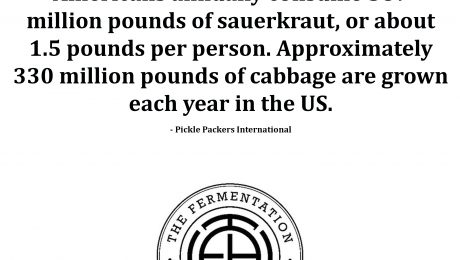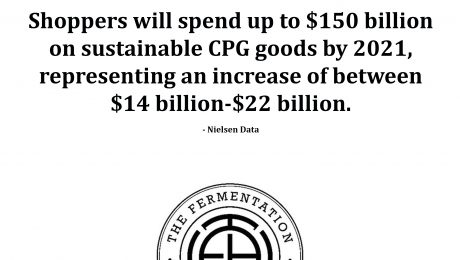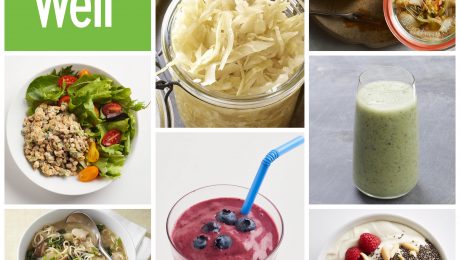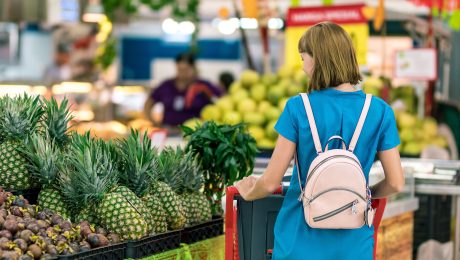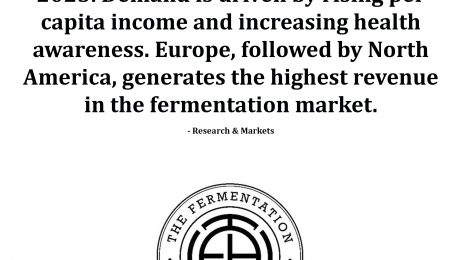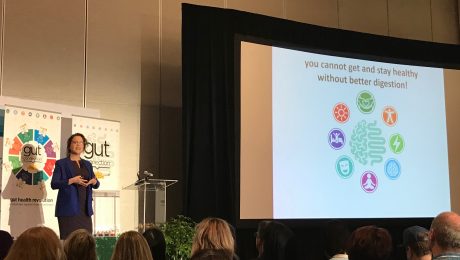Fermented Foods Most Popular Menu Trend
Fermented foods are the most popular menu trend, increasing 149% on restaurant menus in 2018. As customers focus on wellness and gut health, they are ordering more naturally preserved foods in restaurants. – Upserve
- Published in Business
“As the Fermenter, You’re Kind of the Bouncer Outside of the Nightclub,” David Zilber (Noma)
The creative genius behind Noma’s Fermentation Lab, David Zilber says one of the best parts of fermenting is “to get very nerdy and go really deep and taste the whole Patheon of flavors that the microbial world produces.”
Zilber, author of “The Noma Guide to Fermentation” with Noma founder René Redzepi, spoke to Science Friday about his extensive knowledge of the food science craft. When Zilber started at Noma in 2014, he had extensive experience working in high-end restaurants. He had made kimchi working in an Asian restaurant and cooked with amazing soy sauce imported from Japan, but he never gave a second thought as to where the ingredients came from. At Noma, Redzepi noticed Zilber “had a knack for science…I was usually the gut that had the far too detailed answer,” Zilber says laughing as he describes answering colleague’s food questions. Redzepi movied Zilber to the fermentation lab, a world-famous lab that has helped secure Noma’s Michelin ranking as the 2nd best restaurant in the world.
In the radio interview, Zilber details the fermenter’s roll as a scientist, gives advice on preventing mold and shares why he thinks everyone should have a koji started on their counter. Below are highlights from Zilber’s interview with Science Friday host, Ira Flatow.
What is fermentation?
Zilber: The most succinct way I can define fermentation, in Layman’s term, is it’s the transformation of one ingredient into another by way of a microbe. If you imagine you start out with cabbage, then you get lactic acid bacteria to grow in and alongside your cabbage, in two or three week’s time, you end up with sauerkraut. It’s not the same as it was going in. You’ve cultivated — cultured really — this microorganism in your container with your cabbage. And low and behold, this transformation has taken place.
The Noma book says there’s a fine line between rot and fermentation.
Zilber: The rest of the analogy is that, as a fermenter, there’s actually three people in play in the definition of fermentation: the ingredients, the vegetables or the food stuff, the microbes, but also the person whose acting on that situation and actually wiling the ferment into existence. As the fermenter, you’re kind of the bouncer outside of the nightclub. The guy with the velvet rope, the big muscly dude, and you’re deciding who gets into the club and makes a great evening where everyone is sipping champagne and beautiful people all around and all the drunkards and rowdy boys stay outside. So that velvet rope that you use as a fermenter, those are all sorts of control points. Whether that be salt or access to oxygen or temperature or PH and acidity levels, these are all things you have at your disposal as a fermenter to make sure you’re actually fermenting and not rotting. Rot’s a club where everyone gets in; fermentation is where the party is popping.
Take us through lactic acid bacteria and fermentation.
Zilber: Fermentation, it’s one of the simplest processes you could undertake. By adding a little bit of salt to let’s say were talking like sauerkraut. You have your cabbage, you shred it to rupture the cabbage cells, and it makes it easy for bacteria to get inside there. Now lactic bacteria are all around us. They live on your skin, they’re on the skins of fruits and vegetables, they’re basically ever present in our environment. And as you add salt to that shredded cabbage, you’re making sure that any malevolent microbes — things that might cause the mixture to rot — are kept at bay. Salt is a really great anti-microbial, but lactic acid bacteria have a little bit of resistant to it, they can tolerate salt up to a certain point. So, you kind of clear the playing field for lactic acid bacteria to do their thing. They start consuming the carbohydrates and sugar in that cabbage and in doing so they leave something else behind, and that something else is an exclusionary chemical. That’s lactic acid. It sours the mixture and then makes it even harder for different things to grow. And overtime, that fermentation process peters out, they consume as much sugar as they can, the PH drops because of all the lactic acid they’ve produced, you have sour cabbage literally translated from German sauerkraut.
What’s the difference between pickled and fermented?
Zilber: Anyway you break it down, a pickled product is fermented. Now there’s two routes to picking — you can either do a quick pickle, which is making vinegar and then boiling your vinegar with a bit of salt and sugar and spices and then pouring that over your vegetables, or you can sour your vegetables into a pickle. Now the difference is there’s two different acids at play in there. With a quick pickle, a vinegar pickle, you’re using acetic acid. But with a sour pickle, you’re using lactic acid. So, a vinegar pickle, you have to first make the vinegar, and that is the sugars of fruits first transformed into alcohol by yeast and then another fermentation process happens. You have acetic acid bacteria, another ever present bacteria that is floating on dust in the air that will settle on an open bottle of wine and eventually sour it into vinegar. That gets poured over your vegetables, whether that’s carrots or radishes or cucumbers, and the PH drops so much so that its effectively preserved.
Lactic acid fermentation, the sour pickle, that’s the process I just described with sauerkraut, you’re getting it all to happen at once, you’re getting that bacteria to grow in and around the vegetable you’re looking to ferment, and it sours the brine, it sours the plant matter itself, and in one shot you have a pickle you can keep in your fridge for months.
Does fermentation always produce alcohol as a byproduct?
Zilber: No, it does not. There are many different types of fermentation, and some types of fermentation have nothing to do with alcohol at all. Now a biochemist might say, technically, that’s wrong because the very strict, textbook definition of fermentation is the transformation of glucose into ethanol in an enzymatic pathway by yeast. But, in the real world, in the much broader sense, as I said there’s all sorts of different metabolites or byproducts that you end up with in fermentation. Sometimes its sugar or MSG, the actual flavor of umami. Sometimes its alcohol. Other times it’s acids. So there’s a whole plate of different end products in the world of fermentation. And the more you understand it, the more you can kind of paint with these flavors and really tweak the world of food to your will.
What are are your recommendations for someone getting into fermentation?
Zilber: For the novice, start with the things you like eating before you start making things you’ve never really had before, before you try and get into the first half into the process of making soy sauce, start with something you really like eating, if you love pickles on your hot dogs, make pickles for the first time. It’s really easy. It’s something you can do on your kitchen counter, you can watch it happen before your eyes. For a citizen scientist who wants to go a little deeper, I think it’s really fun to take like craft brewing and really try to understand the world of yeast, which there really are like tens of thousands of different varieties that all have these different flavor profiles.
And the coolest thing about fermenting at home, and really getting into it and getting really nerdy with it, is you almost get to taste places on earth in your own garage or in your own apartment. You can get yeasts from Belgium and taste a piece of history because these yeasts have been cultivated in the rafters of abbeys that Belgian monks are famed for making their beers in. So it is really cool to get very nerdy and go really deep and taste the whole Patheon of flavors that the microbial world produces. But that’s one of the funest parts about fermenting. Once you start making fermenter friends, people are just sharing culture and having a good time and you get to taste a little big or someplace else.
What are you excited about in fermentation?
There’s a lot of things that people in the world of fermentation know really well, that’s because all of these ferments that we consume on the regular — whether it’s chocolate or coffee or pickles or wine — these are all very traditional products that have been passed down through generations over hundreds of years, that’s why we still make them today. But in the same way that that makes fermentation amazing, I also think of the way pharmaceutical companies send out teams of scientists into the Amazon jungle to find a rare type of mushroom that might produce some type of miracle drug that will change the face of the pharmaceutical industry. I wish there was someone like that in the world of fermentation, looking for that rare microbe that would produce a flavor no one has ever tasted yet.
What exactly is kombucha?
Zilber: Kombucha is a sweet and sour microbial tonic, I guess you could call it. But folklore goes back to an ancient Korean physician that would travel around Asia, again I don’t even know when in history this would have taken place, but that this physician would brew this drink and kind of heal people with it. Kombucha is basically sweetened tea that is then fermented in a symbiotic way by yeast, which converts the sugar into alcohol, and then acetic acid bacteria that convert that alcohol immediately into acetic acid, the acid that you taste in vinegar, like white vinegar. Now if you drink kombucha and you buy it off the store shelf, sometimes it might taste really vinegary and that is probably because, in my opinion, it’s over fermented. The thing you have to understand about fermentation is fermentation is cooking, it’s just cooking that happens much more slowly. So just in the same way you can overcook a piece of chicken by roasting it in a pan for too long, you can also over ferment something like a kombucha and make it too sour by letting it ride out on your kitchen counter for three weeks instead of two. And sometimes if you taste a kombucha and you’re like “Oh, this it a little hard to get down,” try making it yourself with some of the guidelines in the book and you might find that’s its really, really pleasant to drink.
Are there live probiotics in kombucha?
Zilber: There can be. Kombucha can be pasteurized, just like you know milk can be pasteurized or canned goods can be pasteurized. You can heat it and kill everything in it and not really affect the taste that much. If they say that there are live cultures in it, it means that it was fermented and nothing was really done to it after it was put in a bottle. Now there’s a lot of conflicting information about kombucha out there. And I’ve read a lot of pretty hardcore studies that say, well, a lot of this is a bit bunk. But at the end of the day, I’d probably say that drinking kombucha is probably better for you than drinking a can of Coca-Cola.
How do you handle prevent mold in sauerkraut?
Zilber: That is something you are constantly trying to fight back, especially when you lacto-ferment in something like a crock. There are so many variables that go into making a successful ferment. How clean was your vessel before you put the food in there? How clean were your hands, your utensils? How much salt did you use? How old was the cabbage you were even trying to ferment in the first place? Every little detail is basically another variable in the equation that leads to a fermented product being amazing or terrible. It’s a little bit like chaos theory, it’s a little bit like a butterfly flapping its wings and Thailand and causing a tornado in Ohio. But with lots of practice, you’ll begin to understand that, if it was 30 degrees that day, maybe things were getting a little too active, maybe the fermentation was happening a little bit too quickly. Maybe I opened it a couple times more than I should of and it was open to the air instead of being covered. So there’s lots of variables. But I would say that, if you’re having a lot of trouble with mold, just up the salt percentage by a couple percent. It will make for a saltier sauerkraut, but it will actually help to keep those microbes at bay.
In the book, you say koji is indistinguishable from magic. What is koji?
Zilber: It’s the biggest microbe you’ve never heard of it. Koji is responsible for everything tasty that comes out of east Asia. From China to Korea to Vietnam to especially Japan, it is a mold, a helpful mold called aspergillus oryzae. It is responsible for turning the starches in rice and barley and all sorts of grains into sugar. And it’s turning the protein in those same grains into the flavor umami. It’s responsible for soy sauce, for sake, for rice wine vinegar, for miso and it can be used in all sorts of novel and inventive ways as well. But you never see it as a finished product because it usually is kind of the first step in that process. I liken it to the step of molting barley when you make beer or whiskey. That’s basically how ancient Asia’s civilization came about that process of turning grains into something sweet that you can then ferment with yeast. They found a mold instead of finding the process of molting, and it’s absolutely remarkable for the flavors it brings to the table themselves.
How do you get koji?
Zilber: There’s a line that I say when people ask “How do start growing koji.” All life comes from life, all life comes from cells. At the end of the day, everything living on earth today has been an unbroken chain of succession for three and a half billion years, and koji is no exception. If your kid wants a golden retriever puppy for Christmas, you have to find a golden retriever mom. And it’s the same for koji, you’re going to have find a koji breeder and actually get some spores from them. We buy ours from a laboratory in japan, and we have them shipped over to Copenhagen.
- Published in Science
Americans Consume 387 Million Pounds of Sauerkraut a Year
Americans annually consume 387 million pounds of sauerkraut, or about 1.5 pounds per person. Approximately 330 million pounds of cabbage are grown each year in the U.S.
– Pickle Packers International
- Published in Food & Flavor
“I’ve Never Seen Such A Time of Challenge” Grocery Industry Ripe for Disruption from Small- to Mid-Sized Brands
The grocery market is being disrupted in a way never seen before – and the opportunity for success is great for small- to medium-sized food brands wanting to get in the door.
“I’ve never seen such a time of challenge up and down the value chain from the seed all the way to the table,” says Walter Robb, former CEO of Whole Foods and the founder of investment firm Stonewall Robb. “We’re going to see a whole explosion in the new types of foods that are coming to market.”
A report by Biodiversity International found that three-quarters of the world’s food supply comes from just 12 crops and five livestock species. That jarring lack of diversity in the average diet is changing, Robb said. We’re in a frontier where food “will come back in a way we’ve never imagined.” More than 10,000 new products are introduced to the grocery market every year, and customers Robb said are “clamoring” for something new.
“We have a disruption up and down the value chain like I have never seen,” Robb said. “Your chance to come and bring a new product to market is there.”
Robb spoke at the NOSH Live event in New York, and shared insights into where the food industry is headed. Here are Robb’s five main points.
- Integrated Shopping
“The integrated retail is the table stakes for the future,” Robb said. “We’re going to see the line between digital and physical is going to collapse and it’s really going to be all about the customer and how you’ll serve the customer.”
The food industry will thrive on an “extended experience,” a term Robb came up with in the ‘90s while at Whole Foods. The extended experience extends outside the four walls of the stores. The problem at Whole Foods, Robb pointed out, was the natural grocer didn’t digitize fast enough. So in 2017, Amazon bought Whole Foods in a $13.7 billion deal.
Though customers are making more digital purchases, they are not abandoning physical stores. In five years, 50-60% of business will be done via retail stores.
“The future is one that integrates humanity and technology,” Robb said. “Why? because human beings are human beings and they want connection and community and that’s simply not available online. The most successful brands today and the ones that do more physical and digital.”
He pointed to Target as an excellent integration example for modern shoppers. Shoppers can still go to the store, where Target is remodeling physical locations to enhance the in-store experience, but they can use the Target app to prepopulate a shopping list, check real-time stock and order at home for drive-up pickup.
“Data shows the customers likes to do both (online and in-store shopping),” Robb said. Brands who want a lifetime legacy need to be in both places. “The customer is clearly saying ‘Let me do what I want, when I want.’ And brands that don’t serve them in that way will not see the type of growth that they could if they would. The customer is in charge of the choices now.”
- Microbiome is the Future
The microbiome will “completely revolutionize the food industry” as the future of grocery retail is driven by customers who want to see authenticity with the brand they’re supporting.
Robb pointed t a New York Times article on personalized diets, “The A.I. Diet.” As more research publishes on the microbiome, personalized diets will play a huge role in shopping habits. Medicine and technology are converging with food.
- Create Purpose-Driven Brand
Brand leaders in the 21st Century must be authentic, vulnerable and humble. They must be purpose-driven to be successful, Robb said.
“The whole reason you’re in business is not to make money, money is a byproduct,” Robb said. “What you’re in business to do is to bring change to the world. That’s what purpose is. Purpose is the why, why do you exist as a company. You damn well better have a good answer to that question as to what you’re doing in business. You better be here for some great reason to make an impact on the world. And if you’re not playing on that level, either w your customer or your team members, you’re going to fall behind because the companies that are going to lead with some sense of purpose are going to be the companies that win in the next number of years.”
He advised brands to get fired-up about principles that support values. The company culture is a result of that principles and values, and culture is dependent on how team members feel working for the brand and customers feel buying from the brand.
“The winning formula today is road runners and roots,” Robb said. Roots ground a brand in purpose, but brands can’t cement themselves in the ground. They must be a road runner and change on a dime as the marketplace shifts.
- Solve Customer Confusion
The International Food Council found 80% of customers are confused on their food choices. There are dozens of food tribes dominating grocery shelves, like gluten-free, keto, paleo and Whole 30. With an overload of information, customers don’t know exactly what to buy for their desired health benefits.
Robb said one of the business opportunities for brands today is to figure out how to communicate more clearly with the consumer. Consumers want to make informed choices, but “that last mile of data has not been solved for.”
He pointed to solutions in connected homes devices like Amazon that will now populate a shopping list for the consumer based on past purchases. Consumers don’t even need to pick out what they want, their only roll will be to confirm the purchase.
- Natural Reigns
Organic has grown to a $65 billion industry, with a 7-8% growth rate; conventional food, meanwhile, is only growing at 1-2%. Major mainstream retailers are rushing to get into the natural food business today.
Robb said the best way for brands to get on the shelves at Whole Foods is to push the envelope. Whole Foods continues to lead the natural market, and the grocer wants to see edgy, new products with a new take.
Customers expect food brands today to be transparent, accountable and responsible. Robb said there are 2,000 natural flavors approved for use in food by the Food and Drug Administration. But Robb encouraged brands to solve that problem – use less processed ingredients and more natural ingredients, “let’s continue to lead by showing there’s a new edge in the food industry.”
- Published in Business
Sustainability Sells, Shoppers will Spend $150 Billion on Sustainable Goods by 2021
Sustainability sells. Shoppers will spend up to $150 billion on sustainable CPG goods by 2021, representing an increase of between $14 billion-$22 billion. – Nielsen Data
- Published in Business
Eating Well Publishes 7 Must-Eat Fermented Foods for Healthy Gut
Dietician Lisa Valente writes in Eating Well the seven must-eat fermented foods for a healthy gut. Her list features: sauerkraut, kimchi, kefir, kombucha, miso, tempeh and yogurt. She writes: “Fermented foods are a hot health topic—and for good reasons. These good bacteria—particularly those in our gut—may improve digestion, boost immunity and help us maintain a healthy weight. Research is still emerging on just how important these mighty microbes might be for our health, but the early results are promising. Take care of your gut, and in turn, it will take help take care of you.”
Read more (Eating Well)
- Published in Health
New York Times Publishes How-To on Home Brewing
Further sign that kombucha has hit the mainstream: The New York Times publishes a how-to on home brewing kombucha, “How to Make Kombucha, or How I Met Your Mother.” Their photo of a scoby hotel — or “scotel” as the article calls it — is stunning.
Read more (New York Times)
- Published in Food & Flavor
10 Grocery Store Trends for the Fermentation Industry
From grocery delivery to functional ingredients, consumer demands are defining American’s grocery lists. Today’s average grocery shopper is shopping more, but in smaller quantities. They’re also on the hunt for functional products that they’ve read about on social media.
Adapting to these trends is important for fermentation brands. As fermentation enters the mainstream, fermented food and drink brands need to focus marketing efforts on educating consumer’s on fermentation’s health benefits.
Here are 10 grocery store trends reshaping the way Americans buy food.
- Quick Trips Become Standard Instead of Stockpiling
Consumers don’t go to the grocery store once a week for an hour to buy everything on their list. They’re stopping in the grocery store multiple times a week for quick as-needed trips. According to Nielsen, 10 percent of shoppers buy just the ingredients for the meal they plan to have that day.
- Functional Foods Core of Shopping Lists
Consumers want food that heals (gut bacteria restoration, weight management), food that meet dietary needs (gluten free, sugar free) and food packed with functional elements (energy booster, stress reducer). Nearly two-thirds of American adults say healthfulness has a significant impact on their food and beverage purchases, according to the Institute of Food Technologists. The sales of functional foods totaled $247 billion in 2018.
- Private Label Products Grow
Private labels are growing in popularity – eight in 10 Americans buy private label products frequently or occasionally, according to IRI Consumer Connect. Private label is especially popular with younger consumers; 92 percent of millennials buy private label products to save money (compare that to 86 percent of Generation Xers, 81 percent of Baby Boomers and 77 percent of seniors). Private sales increased 5.8 percent in 2018 compared to 1.5 percent for national brands.
- More Fresh Food Options
Shelf-stable food – like protein bars, pasta sauces, salad dressings and sauerkraut – are getting much fresher alternatives. Brands are turning traditional shelf-stable food into refrigerated varieties that are packed with healthier ingredients and less preservatives.
- In-Store Experiences Elevate Displays
Stores and brands are keeping customers in the store by turning grocery shopping into an experience. Unique displays, samples and cooking demonstrations are making grocery shopping personal.
- Smaller Stores Become Commonplace
As malls collapse and strip malls anchor spaces are given to entertainment and lifestyle stores, the grocery store footprint is shrinking. Nielsen found smaller stores account for 25 percent of FMCG (fast-moving consumer goods) sales and 70 percent of shopping trips.
- Omnichannel Sales Diversify Grocers
Catering to the busy consumer, retailers are adding multiple channels to the shopping experience, like grocery delivery, in-store pickup and online shopping. According to Nielsen and Rakuten Intelligence, in-store grocers still remain king with $413 billion in sales in 2018. But online grocers netted $21.6 billion in sales, almost half (48 percent) in click-and-collect, pickup purchases. Though e-commerce sales are smaller than in-store sales, e-commerce has 40 percent year-over-year dollar growth.
- Rise of Natural & Organic Industry
Once specialty items only found in small nutrition shops, today natural products are the new normal for consumers. Annual consumer sales in 2018 were $219 billion across the natural and organic products industry, a 7 percent increase.
- Shopper Data Mined and Personalized
Outside of sales, stores will use loyalty programs and in-store AI machine learning to capture customer data and habits. That data will maximize product recommendations and coupons for customer’s future in-store and online purchases.
- Social Media Influence Food Purchasing Decisions
More shoppers are turning to social media in the purchase cycle. Nielsen found 35 percent of consumers use social media to aid in their purchasing decisions, while 26 percent said they discovered new products on social media.
- Published in Business
Fermentation Market Projected to Reach $689.34 Billion by 2023
The fermented food and ingredient market is projected to reach $689.34 billion by 2023. Demand is driven by rising per capita income and increasing health awareness. Europe, followed by North America, generates the highest revenue in the fermentation market.
- Published in Business
As Consumer Distrust in Probiotic Pills Grows, Fermentation Brands Need to Educate on Benefits of Live Bacteria
Probiotic supplements have been the hype of the health industry for the past few years, but the rage is dissipating. Consumers are starting to distrust probiotic pills, realizing a pill alone doesn’t deliver on promised health benefits.
“The thing is, you can’t just pop in a probiotic and get better health,” said Ashley Koff, a registered dietician and CEO of the Better Nutrition Program. “Consumers are waking up to the fact that our digestive health is more complicated than this. We need to start looking beyond probiotics.”
Good gut health requires more than just a single daily probiotic pill. Fermentation brands need to consider all the nutrients needed for a healthy gut as products are evaluated, marketed and advertised.
“You’re actually not what you eat. You are what you digest and absorb…The demands of our digestive health go so far beyond the probiotics,” said Koff, who spoke at Expo West on “Gut Health Revolution: A Radical New Approach Beyond Probiotics.” “When we walk about gut health, we often think about our stomach or our colon. But what were really talking about here are a bunch of different organs. We have to nourish multiple organs with complementary nutrient demands.”
The digestive system is the core to the entire body system. Koff said: “We cannot get and stay healthy without better digestion.” Most digestive health products isolate nutrients specific to one organ, she added. So while a probiotic may help the small intestine, for example, what feeds the probiotic? What makes the probiotic thrive?
Koff said most probiotic supplements and probiotic-infused products ignore other nutrients. What about magnesium, that helps relax the digestive tract? Probiotic supplements have been marketed as a one-time solution when other critical minerals, antioxidants, amino acids, fatty acids and alkaline are just as critical for gut health.
“We want to make sure we’re getting those nutrients that nourish the microbiome,” Koff said. Live, active bacteria will nourish the good bacteria in the gut, building the immune system. “If we’re getting probiotics, we need to get in prebiotics as well.”
Probiotics made $2 billion in sales in 2018, but their sales are slowing. Prebiotics, however, are doubling sales growth.
Simply put, prebiotics are the foods microbes in the gut like to eat. Mayco Clinic describes prebiotics as “specialized plant fibers (that) act like fertilizers that stimulate the growth of healthy bacteria in the gut.” Probiotics, on the other hand, are living organisms in specific straings of bacteria. Fermented foods are full of live, active cultures, like yogurt, sauerkraut, kimchi and kombucha.
Koff said people shouldn’t be getting all their prebiotics from a supplement. Most prebiotics should come from food.
“It should be deliciously easy for us to get the nutrients that help our gut,” Koff said. “No supplement in the world can override a poor-quality diet. …That’s why it’s so important when you look at a prebiotic that you’re looking at something that’s a whole food, (especially) if a whole food gets fermented.”
Relying on food for all nutrients, though, is hard for the majority of people, Koff revealed. If your probiotic choice is granola, for example, are you going to continue eating that same granola and that same service every day to consistently meet your probiotic needs? And a very small number of people actually eat gut-boosting foods daily. “I find that’s a limiting factor,” Koff said.
Koff specifically touted Country Life’s new line of digestive aids, called Gut Connection. The prebiotics contain EpiCor, a whole food prebiotic. The Gut Connection line contains eight products consumers can take for their needs, like balancing digestive, mood, sleep, stress or weight. Country Life sponsored Koff’s education session.


